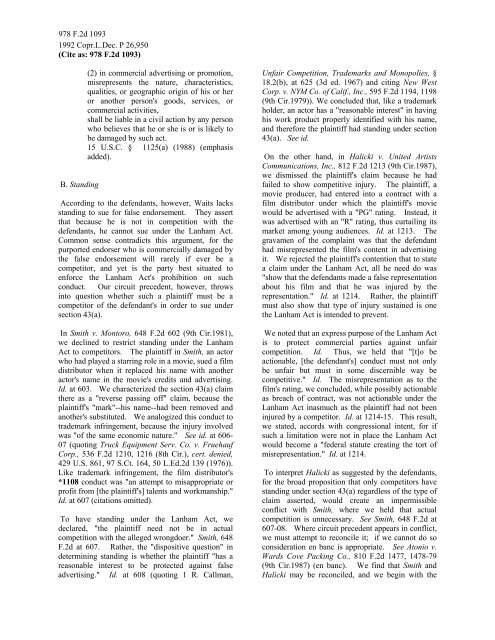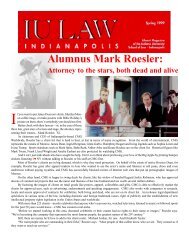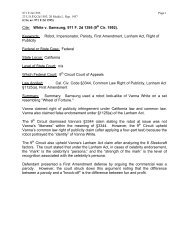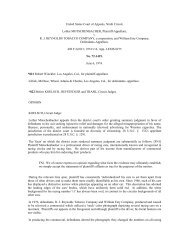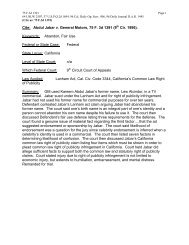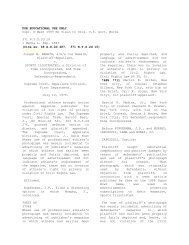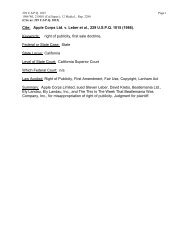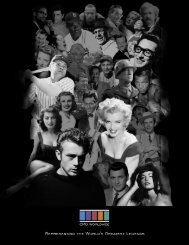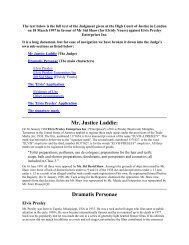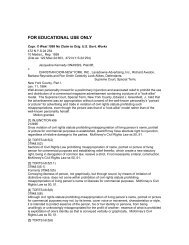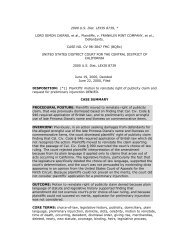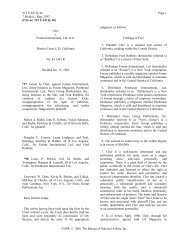Cite: Waits v. Frito Lay, 978 F. 2d 1093 (9th Cir. 1992 ... - Mark Roesler
Cite: Waits v. Frito Lay, 978 F. 2d 1093 (9th Cir. 1992 ... - Mark Roesler
Cite: Waits v. Frito Lay, 978 F. 2d 1093 (9th Cir. 1992 ... - Mark Roesler
You also want an ePaper? Increase the reach of your titles
YUMPU automatically turns print PDFs into web optimized ePapers that Google loves.
<strong>978</strong> F.<strong>2d</strong> <strong>1093</strong><br />
<strong>1992</strong> Copr.L.Dec. P 26,950<br />
(<strong>Cite</strong> as: <strong>978</strong> F.<strong>2d</strong> <strong>1093</strong>)<br />
B. Standing<br />
(2) in commercial advertising or promotion,<br />
misrepresents the nature, characteristics,<br />
qualities, or geographic origin of his or her<br />
or another person's goods, services, or<br />
commercial activities,<br />
shall be liable in a civil action by any person<br />
who believes that he or she is or is likely to<br />
be damaged by such act.<br />
15 U.S.C. § 1125(a) (1988) (emphasis<br />
added).<br />
According to the defendants, however, <strong>Waits</strong> lacks<br />
standing to sue for false endorsement. They assert<br />
that because he is not in competition with the<br />
defendants, he cannot sue under the Lanham Act.<br />
Common sense contradicts this argument, for the<br />
purported endorser who is commercially damaged by<br />
the false endorsement will rarely if ever be a<br />
competitor, and yet is the party best situated to<br />
enforce the Lanham Act's prohibition on such<br />
conduct. Our circuit precedent, however, throws<br />
into question whether such a plaintiff must be a<br />
competitor of the defendant's in order to sue under<br />
section 43(a).<br />
In Smith v. Montoro, 648 F.<strong>2d</strong> 602 (<strong>9th</strong> <strong>Cir</strong>.1981),<br />
we declined to restrict standing under the Lanham<br />
Act to competitors. The plaintiff in Smith, an actor<br />
who had played a starring role in a movie, sued a film<br />
distributor when it replaced his name with another<br />
actor's name in the movie's credits and advertising.<br />
Id. at 603. We characterized the section 43(a) claim<br />
there as a "reverse passing off" claim, because the<br />
plaintiff's "mark"--his name--had been removed and<br />
another's substituted. We analogized this conduct to<br />
trademark infringement, because the injury involved<br />
was "of the same economic nature." See id. at 606-<br />
07 (quoting Truck Equipment Serv. Co. v. Fruehauf<br />
Corp., 536 F.<strong>2d</strong> 1210, 1216 (8th <strong>Cir</strong>.), cert. denied,<br />
429 U.S. 861, 97 S.Ct. 164, 50 L.Ed.<strong>2d</strong> 139 (1976)).<br />
Like trademark infringement, the film distributor's<br />
*1108 conduct was "an attempt to misappropriate or<br />
profit from [the plaintiff's] talents and workmanship."<br />
Id. at 607 (citations omitted).<br />
To have standing under the Lanham Act, we<br />
declared, "the plaintiff need not be in actual<br />
competition with the alleged wrongdoer." Smith, 648<br />
F.<strong>2d</strong> at 607. Rather, the "dispositive question" in<br />
determining standing is whether the plaintiff "has a<br />
reasonable interest to be protected against false<br />
advertising." Id. at 608 (quoting 1 R. Callman,<br />
Unfair Competition, Trademarks and Monopolies, §<br />
18.2(b), at 625 (3d ed. 1967) and citing New West<br />
Corp. v. NYM Co. of Calif., Inc., 595 F.<strong>2d</strong> 1194, 1198<br />
(<strong>9th</strong> <strong>Cir</strong>.1979)). We concluded that, like a trademark<br />
holder, an actor has a "reasonable interest" in having<br />
his work product properly identified with his name,<br />
and therefore the plaintiff had standing under section<br />
43(a). See id.<br />
On the other hand, in Halicki v. United Artists<br />
Communications, Inc., 812 F.<strong>2d</strong> 1213 (<strong>9th</strong> <strong>Cir</strong>.1987),<br />
we dismissed the plaintiff's claim because he had<br />
failed to show competitive injury. The plaintiff, a<br />
movie producer, had entered into a contract with a<br />
film distributor under which the plaintiff's movie<br />
would be advertised with a "PG" rating. Instead, it<br />
was advertised with an "R" rating, thus curtailing its<br />
market among young audiences. Id. at 1213. The<br />
gravamen of the complaint was that the defendant<br />
had misrepresented the film's content in advertising<br />
it. We rejected the plaintiff's contention that to state<br />
a claim under the Lanham Act, all he need do was<br />
"show that the defendants made a false representation<br />
about his film and that he was injured by the<br />
representation." Id. at 1214. Rather, the plaintiff<br />
must also show that type of injury sustained is one<br />
the Lanham Act is intended to prevent.<br />
We noted that an express purpose of the Lanham Act<br />
is to protect commercial parties against unfair<br />
competition. Id. Thus, we held that "[t]o be<br />
actionable, [the defendant's] conduct must not only<br />
be unfair but must in some discernible way be<br />
competitive." Id. The misrepresentation as to the<br />
film's rating, we concluded, while possibly actionable<br />
as breach of contract, was not actionable under the<br />
Lanham Act inasmuch as the plaintiff had not been<br />
injured by a competitor. Id. at 1214-15. This result,<br />
we stated, accords with congressional intent, for if<br />
such a limitation were not in place the Lanham Act<br />
would become a "federal statute creating the tort of<br />
misrepresentation." Id. at 1214.<br />
To interpret Halicki as suggested by the defendants,<br />
for the broad proposition that only competitors have<br />
standing under section 43(a) regardless of the type of<br />
claim asserted, would create an impermissible<br />
conflict with Smith, where we held that actual<br />
competition is unnecessary. See Smith, 648 F.<strong>2d</strong> at<br />
607-08. Where circuit precedent appears in conflict,<br />
we must attempt to reconcile it; if we cannot do so<br />
consideration en banc is appropriate. See Atonio v.<br />
Wards Cove Packing Co., 810 F.<strong>2d</strong> 1477, 1478-79<br />
(<strong>9th</strong> <strong>Cir</strong>.1987) (en banc). We find that Smith and<br />
Halicki may be reconciled, and we begin with the


